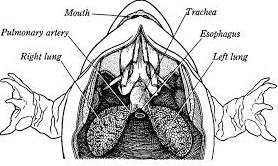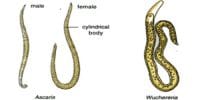Bucco-pharyngeal Respiration System of Toad:
Bucco-pharyngeal respiration is simply known as mouth respiration. The membrane of the buccal cavity and pharynx of a toad is very thin and there are innumerable capillaries. When air enters the buccal cavity oxygen gets into the blood of the capillaries by diffusion. The buccal cavity consists of moist mucous membranes and richly supplied with blood capillaries. This oxygenated blood flows to different parts of the body through the heart and at one stage takes part in the oxidation of food inside the cell. Oxygen dissolves in moist mucous of the cavity and diffuses into the blood capillaries. The lungs do not take part in this respiration.

fig: Bucco-pharyngeal Respiration System
Buccopharyngeal respiration occurs through the lining of the mouth. The carbon dioxide produced as a result of oxidation of food comes out through diffusion. This only occurs when the toad is not submerged in water. The toad respires this way generally during rest. Bucco-pharyngeal respiration occurs through the lining of this mouth. The lining of the mouth is very moist and can be used to bring oxygen into the bloodstream by dissolving it and diffusing it into the blood capillaries, in a similar way to the skin respiration system. This only occurs in the event the frog is certainly not submerged in water.
The lining on the mouth is quite moist and can often bring oxygen into the bloodstream by dissolving the idea and diffusing it into the blood capillaries, in the same way to the epidermis or skin respiration system.














